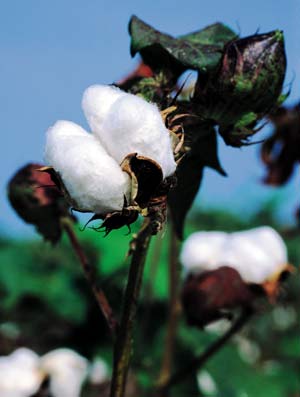Keeping Cotton King – A Tribute to the Eradication of the Boll Weevil in Alabama

Almost a century ago, a tiny pest nearly eliminated Alabama’s biggest row crop. But an eradication program first criticized by some farmers and embraced by others not only salvaged cotton in Alabama, it eventually returned it to the status of king of row crops in the state.Crossing the Rio Grande into Texas in 1892, the boll weevil marched unabated across the southern United States eastward and, by 1917, was bankrupting Alabama farmers. It forced south Alabama farmers to turn to peanuts, and the famous Boll Weevil Monument was erected in Enterprise to celebrate the switch.
Throughout the following decades, farmers who continued to farm cotton struggled with controlling the pest. Many different chemicals were tried, and strict environmental regulations made the task even more difficult because cotton required more spraying than any other row crop. In 1983, Alabama farmers became very interested in the success of the Boll Weevil Eradication Program in North Carolina. To learn first hand about the program, the Alabama Farmers Federation organized a trip there which included Commissioner of Agriculture Albert McDonald, Lt. Gov. Jim Folsom Jr. and other legislative leaders. Legislation was drafted and passed in 1984. McDonald was given authority to appoint a five-member board of the Boll Weevil Eradication Foundation of Alabama. Original members were W. L. “Sonny” Corcoran, Jimmy Sanford, Guy Karr, Claude Buchanan and Andy Ellis. They held their first meeting in October 1985, and two months later, the first referendum to launch the program passed in 13 southeast Alabama counties. The actual eradication began in September 1987 and involved only counties in south Alabama, part of the Florida panhandle and most of Georgia.Fluorescent green, plastic boll weevil traps shaped like space capsules began appearing in cotton fields in the eradication area. A hormone attractant lured the weevils into the traps so they could be counted. The number of weevils in the traps determined when to spray and the success of the eradication. Traps still dot the state but now, thankfully, remain empty since the elimination of the pest. The second referendum was held in July 1987 to expand the program into southwest Alabama. After a number of farmers complained about high assessments, a third referendum was held in March 1989 to reconfirm the program. Requiring a two-thirds vote, 75 percent voted to continue the eradication program.A fourth referendum in April 1989 almost killed the program. It was called to increase assessments for growers due to cost overruns. Only 54 percent favored
it, far short of the two-thirds vote required. After an educational process to convince farmers to change their stance, a fifth referendum was held in June 1990, and the program was reinstated by a 91 percent margin. Two other referenda were held in 1992 to expand the program to other parts of the state. Both failed. Later votes were successful, and the program eventually covered the state.The program was paid for partly by federal funds, but farmers were assessed an amount per acre to cover chemical costs. Fortunately, the Alabama Legislature, with strong backing from the Alabama Farmers Federation, approved more than $21 million over a 12-year period to help offset the portion Alabama farmers had to pay. In the early stages of the program, many farmers opposed it because of the cost and also because of an outbreak of armyworms and tobacco budworms. In one field, there were reports of 150 to 200 worms per foot. Meanwhile, environmentalists were opposing aerial spraying and the chemicals that were used.Throughout the program, supporters urged everyone to be patient because spraying eventually would be greatly reduced and beneficial insects would return, benefiting everyone both financially and environmentally. Of course this has proven to be true as Alabama now has no weevils within its border. Farmers who once sprayed 8 to 10 times may now spray only once, benefiting the environment and greatly reducing chemical costs. And while there were 333,000 acres of cotton in Alabama in 1987, there were 610,000 acres harvested last year. The Boll Weevil Eradication Program is a tremendous success story. While the pest has disappeared from our state, the familiar fluorescent green plastic traps remain as the first line of defense to warn farmers if the tiny bug tries to return.Click below to read profiles of the five orginal Boll Weevil Eradication Foundation Board members.Claude Buchanan
Sonny Corcoran
Andy Ellis
Guy Karr
Jimmy Sanford
